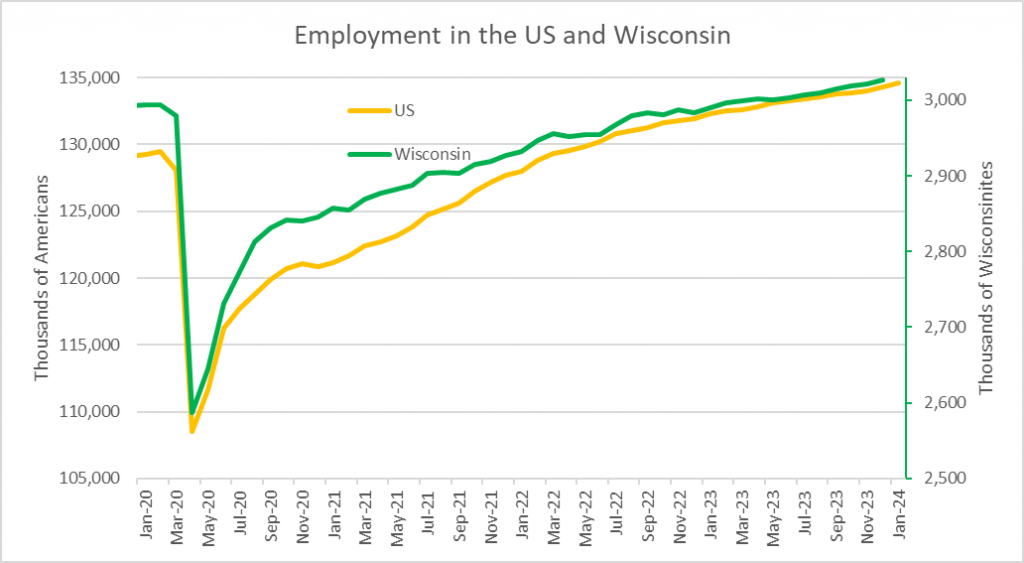How Healthy Is The Wisconsin Economy?
Poll reveals Republicans higher on Wisconsin than U.S., but what do economic indicators say?
The most recent Marquette University Law School poll asked Wisconsin voters to rate the national and state economies, using four categories: excellent, good, not so good and poor. Far more respondents viewed things negatively than positively. Are they right?
The graph below summarizes the responses for the U.S. economy. To get a clearer view of overall sentiment, I combined the numbers of the first two categories and the numbers choosing “not so good” and “poor.”
Notably, Republicans were far more negative on the economy than Democrats were positive, reflecting the ecosystem they live in. For example, an article in the Journal Sentinel on Eric Hovde’s plans to run against Senator Tammy Baldwin notes that he “traveled the state over the last several months speaking at various Republican events. … he made inflation and the nation’s debt a focus as he railed against the Biden administration’s handling of the economy.”
The next graph summarizes responses when asked to similarly rate the Wisconsin economy. On average, the respondents were more positive about Wisconsin than about the nation. Curiously, the difference was due to fewer negative responses from Republicans and independents. Responses from Democrats were essentially the same as for the Wisconsin economy.
Another poll question asked who, Joe Biden or Donald Trump, would be better on the economy? Overall, the respondents chose Trump, as can be seen in the right-hand group of columns in the next graph. But again, the responses heavily reflected partisan preferences, particularly among self-described Republicans. Again, Republicans were much more negative than Democrats were positive.
How strong is the state and nation’s economy? What do the data show? There are a number of ways to measure the strength of an economy. Among them are the unemployment rate, job growth, and the gross domestic product.
The next graph shows the U.S. and Wisconsin unemployment rates since 2008 as reported by the U.S. Bureau of Labor Statistics. Notable is the speed of economic recovery in both Wisconsin and the U.S. following the pandemic, especially compared to the very slow recovery from the Great Recession. This suggests that the policies adopted by the Biden administration and Federal Reserve were effective in rapidly reducing unemployment numbers.
The next graph shows the number of jobs (in thousands) in the U.S. (shown on the left-hand axis) and in Wisconsin (on the right) since just before the pandemic hit in early 2020. In both Wisconsin and the U.S. the number of jobs currently exceeds the number before the pandemic.
Consider the next graph below, which compares two different variables. The first, shown by the green line and the right-hand axis, is the Wisconsin unemployment rate.
The second variable is the difference between the percentage of respondents saying the state is in the right direction versus the wrong track when asked by the Marquette poll. It was calculated by subtracting the percentage saying wrong track from the percentage choosing right direction. The yellow dots on the line show when this question was asked by the poll. Above the dashed zero line, more people chose wrong track than right direction; below that line, right direction predominates.
Ironically, the most positive poll was taken in late March 2020, just as COVID-19 was taking the state and nation in its grip. Since then, even as unemployment decreased, voter perceptions became more negative.
This pattern is not limited to Wisconsin. The next graph compares the U.S. Real Gross Domestic Product (GDP) to the University of Michigan Consumer Sentiment survey a survey of consumer sentiment. The use of “real” to refer to GDP is to indicate that it is adjusted to take out inflation.
Again, following the pandemic, as GDP recovered consumer sentiment became more negative, finally starting to rise late last year.
Part of the explanation for the mismatch between perception and evidence reflects partisanship, the successful MAGA Republican campaign to convince its base that Biden and the Democrats are not just wrong but are villainous. This spirit is reflected in a fundraising email I recently received from the Wisconsin Republican Party entitled “Lyin’ Biden,” it went on:
Bruce, We need your help. Joe Biden and other radical leftists are destroying the country. Bidenomics is failing, the world is more dangerous than it was four years ago, crime is out of control, and our constitutional rights are under attack. We’re counting on you to help us save the United States this November.
Before looking at what these numbers show about consumer perception, it is useful to look at a glitch common to wage surveys. The chart shows spikes in both Wisconsin and U.S. wages in early 2020. Rather than due to employers giving raises as the pandemic hits, the explanation is that it reflects so-called “compensation effects.” Employers faced with a substantial decrease in revenues were most likely to let go of their lower-paid employees, presumably judging that those would be the easiest to replace when business recovered.
An April 19, 2021 blog post, entitled “The Pandemic’s Effect on Measured Wage Growth,” by two members of the federal Council of Economic Advisers discusses this issue. The authors go on to predict a negative spike as the process goes into reverse and employers gear up for increased business. In fact, that prediction came true that very month.
While jobs became plentiful during this period, wages did not keep up with inflation, so many people experienced a decline in real income. Last spring, with the reduction in inflation, real income started growing. If this process continues, it seems likely that hostility to the economy will decrease.
In a recent column published in the New York Times and entitled “What a Split in Consumer Confidence Means for Biden,” Nate Silver makes much the same point. He postulates that for most people, a cut in real income because of inflation affects them more than increased job growth, lower unemployment or growth in the overall economy.
Data Wonk
-
The Imperial Legislature Is Shot Down
 Jul 10th, 2024 by Bruce Thompson
Jul 10th, 2024 by Bruce Thompson
-
Counting the Lies By Trump
 Jul 3rd, 2024 by Bruce Thompson
Jul 3rd, 2024 by Bruce Thompson
-
How Did Politics Affect Covid Deaths?
 Jun 26th, 2024 by Bruce Thompson
Jun 26th, 2024 by Bruce Thompson





























As with most statistics, these are almost meaningless without context. Yes, unemployment is lower and wages have increased by a pcertain percent, but neither are “good” if wages are not livable.
Economy created more unlivable wage jobs?– not such good news any more. Wages went up 6%?– if the wage was unlivable to begin with, it remains unlivable after especially when accounting for inflation.
Resist the temptation to attribute all to partisan bias. Sure, MAGA Republican voters are propagandized. Sure, Democratic and non-MAGA Republicans voters tend to be more factually informed. But, large parts of the electorate are struggling paycheck-to-paycheck with increasing levels of debt. Housing and health care are increasingly unaffordable. A number of market busts have drained retirement accounts. Inflation erased many gains.
Lower-to-middle class people and the younger generations, in particular, have good reasons to conclude the economy is not in good shape, regardless of their political persuasion. Even those who are financially well off, can see the problems are many.